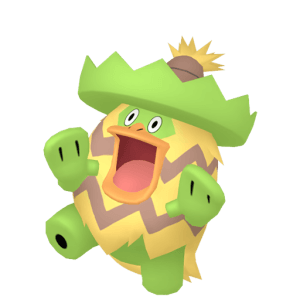In this recurring series, I’ll analyze the origins of Pokémon designs and their allusions to Mediterranean culture from Pokémon Scarlet and Pokémon Violet.
Tandemaus

Tandemaus appears early in the player’s Paldean journey. It, or rather they, are two mice who always appear together. Its name reflects this, a combination of “tandem” and “mouse”. The two mice are presumably a couple, male and female, and technically this Pokémon does not have a specified gender. With patches of slightly blue fur, one appears to be wearing pants while the other appears to be wearing a shirt.

Although white mice are not common in the wild, Tandemaus is presumably based on the Algerian mouse given the similar ear shape. House mice, a close relative of the Algerian mouse, are rodents that are common around the world, having spread as stowaways on ships that traveled and traded across the globe. The Algerian mouse is a subspecies of mouse that is common within the Iberian peninsula.
Exhibiting great teamwork, they use their incisors to cut pieces out of any material that might be useful for a nest, then make off with them.
The pair sticks together no matter what. They split any food they find exactly in half and then eat it together.
Pokédex
House mice near human settlements take advantage of the abundance of spare food and shelter to form nests. Unlike Tandemaus, house mice don’t necessarily form monogamous relationships. They do form families, typically larger ones, with a hierarchy of related mice working together to survive.
Maushold

Tandemaus’ evolution is quite unique — once it levels up in battle in a battle, it will spontaneously evolve into Maushold, although the earliest it can do so is when it reaches level 25. There is no evolution screen, you’ll just suddenly see it in your party when you check your Pokémon.
Evolution for Tandemaus means there are now two smaller mice following behind. One in a hundred Maushold will only have a single mouse. These are presumably the babies of Tandemaus, which have now formed a full family. That’s why this Pokémon’s name is a combination of “Mouse” and “Household”.
The two little ones just appeared one day. The group might be a family of related Pokémon, but nobody knows for sure.
The larger pair protects the little ones during battles. When facing strong opponents, the whole group will join the fight.
Pokédex, Family of Four
They build huge nests with many rooms that are used for different purposes, such as eating and sleeping.
The little one just appeared one day. They all live together like a family, but the relationship between the three is still unclear.
Pokédex, Family of Three
Maushold’s concept is based on the fast pace at which mice breed. They have a gestation period of about twenty days, where they give birth to an average of seven mice, although it can be twice as many. This means that house mice can have as many as ten distinct litters in a year.
The rapid birth cycles of mice are partially why they are so commonly used in labs. It is easy for scientists to model a wide range of biological factors on a particular population, and it’s easy to replace mice. This rapidity also means that mice can quickly become common pests in homes. In addition to eating food, they can chew up wires, damage structures, and carry diseases from fleas and ticks.
The fast gestation process of mice also lends itself to the signature move of Maushold: Population Bomb. This is a powerful Normal-type move with a base power of 20, but it also hits up to ten times. It is also considered a “blade” move boosted by Sharpness, perhaps due to the sharp teeth of the mice.
The move’s name comes from the discredited book The Population Bomb written by Paul Ehrlich, who believed that the rising human population during the twentieth century would lead to resource scarcity and widespread famine. Rather, in the following decades we have seen vast improvements to crop yield and food supply outpacing population growth.
Conclusion
These are cute Pokémon which fit nicely the role of early-route rodents. With a unique evolution method, and a rare form, they do stand out as great designs and additions to any player’s team.










